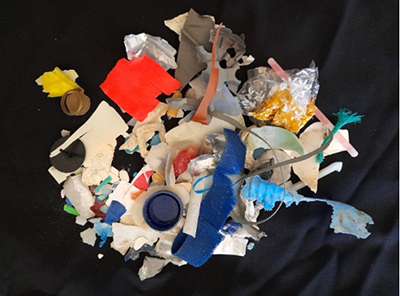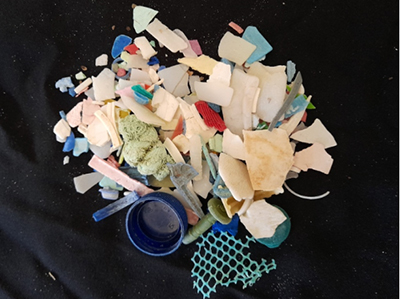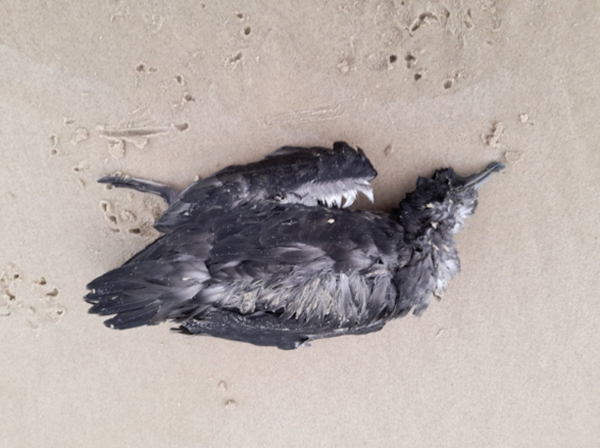Kings Beach, Byron Bay. It looks clean enough, but small pieces of plastic are scattered along the high tideline and more comes in with every tide.
Patrick Couper, Throwaway living – decades of marine damage, Queensland Museum Network, 29 September 2022
Written by Patrick Couper, Senior Curator of Reptiles and Amphibians, Queensland Museum.
The beginning of the Plastic Age
Large-scale plastic production began in the 1940s. Over the following decade, production was stepped-up to supply items for the mass consumer market. Plastic quickly became an integral part of our daily lives. It was hailed as a wonder product, versatile, light weight and cheap, manufactured from hydrocarbons derived from vast, largely untapped, reserves of crude oil.
From the very start we’ve misused plastics
Plastics were quickly regarded as throwaway items, despite their near indestructible nature. In August 1955, Life magazine featured an article titled Throwaway Living – disposable items cut down household chores. It was accompanied by an image of a smiling family waving their arms in the air as a stream of disposables spilled forth from a rubbish bin and circled in the air around them – a vase, food containers, a sectional plate, garbage bags, a dog’s feeding dish, a baby’s bib, a diaper, and more.
Many were products of a booming plastics industry. The article’s opening sentence reads ‘The objects flying through the air in this picture would take 40 hours to clean – except no house-wife need bother. They are all meant to be thrown away after use.’

Global production doubles every 11 years
Global plastic production now exceeds 380 million tonnes annually, with eight to 12 million tonnes making its way to the sea through multiple sources; poorly managed waste facilities, the fishing industry, stormwater, wastewater, illegal dumping, atmospheric fall-out and shipping containers lost at sea – to name a few. Waste plastic has become a major environmental issue. The planet is drowning in this material. It damages ecosystems, diminishes biodiversity and ultimately threatens human health.
A hazard to wildlife
Plastic is especially hazardous to marine wildlife. We’ve all heard of turtles drowning in trawls and discarded fishing nets (ghost nets) and birds entangled in fishing line.
The first evidence of animals ingesting plastic dates to the 1950s, when plastic was removed from the gut of a marine turtle. In 1960, it was found in the gut of a seabird from New Zealand and by the late 60s albatrosses on the north-western Hawaiian Islands were feeding it to their chicks. By the mid-70s, a manatee and some stranded whales were added to the list. Now hundreds of species are impacted by plastic and the list keeps growing.

Plastics have been recorded from all levels of the food chain and, in their smallest form (nanoplastics), they can pass through the gut wall and become embedded in body tissues. Lurking within are a cocktail of chemical additives that, in the laboratory, have been shown to affect gene expression, growth and reproduction.
In the marine environment their toxicity is further amplified by pollutants they absorb from the surrounding seawater.
Why do turtles and seabirds eat plastic?
It is well documented that these animals mistake floating plastic for food. Marine turtles eat plastic bags, likely mistaken for jellyfish, and die from gut blockages.
Plastic is also mistaken for food due to its smell. It provides a substrate that encourages attachment by marine organisms such as algae and small invertebrates (biofouling), hence, it can smell like food. The tube-nosed seabirds, which include albatrosses, petrels and shearwaters, are particularly prone to ingesting plastic. This is because plastic releases dimethyl sulfide gas (DMS) as it degrades. DMS is also released by phytoplankton when it is grazed on by zooplankton. Petrels and their kin are particularly sensitive to plumes of DMS gas that waft into the atmosphere. The smell alerts them to food, concentrations of krill and fish, which they hone in on.
Macroplastic to microplastics
Floating plastic continually degrades in the marine environment, broken into smaller and smaller pieces by exposure to UV light and the sea’s abrasive action.
Small fragments of hard plastic, broken down water bottle caps etc., are a significant cause of mortality for post-hatchling turtles. These animals feed at the surface on macroplankton and will readily ingest other small, floating objects – and fragments of brightly coloured plastic seem to fit the bill.
Every year, post-hatchling marine turtles wash up dead along the South East Queensland coast. Ongoing studies show that many have ingested plastic.

450 years to decompose!
Plastic is extremely durable; it doesn’t go away. A single polyethylene terephthalate (PET) bottle can take 450 years to decompose fully and we’re producing 500 billion of them annually. Sadly, many will end up in the sea.
Little can be done to remove the huge volume of plastic that’s already there, suspended in the water column and buried in deep sea sediments. However, we can clean up what the sea throws back at us, littering our beaches.
Not so clean
Byron Bay is well known for its beautiful beaches, scenic headlands and relaxed living. A beachwalk provides an opportunity to inspect the strandline, to find man o’war jellyfish and violet snails with their bubble rafts. There’s also Glaucus, the Blue Sea Dragon, a strange little sea slug that feeds on jellyfish and incorporates their stinging cells into its own defensive weaponry.
But amongst the flotsam are coloured specks – red, white, blue, green and yellow – tiny pieces of plastic derived from larger objects. It’s these small fragments of hard plastic that are killing the post-hatchling turtles and there are literally trillions of them floating on the surface of the world’s oceans.

What you can do
Plastics and ‘throwaway living’ have shaped society of the last 70 years, but things can change. As a society, we can step up by reducing the production of new plastic and recycling existing material. We can tighten regulations on the disposal of waste and move to eco-friendlier products. Degradable plastics still have a long way to go. Some need industrial composters to break them down and others just degrade to smaller and smaller pieces.
As individuals, we can exclude unnecessary plastics from our lives (there are many books and helpful websites pointing the way). Saying NO to the things we don’t need can change industry and shape a cleaner world.


